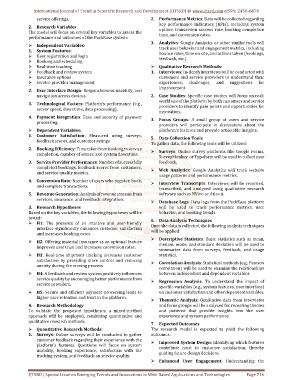Page 726 - Emerging Trends and Innovations in Web-Based Applications and Technologies
P. 726
International Journal of Trend in Scientific Research and Development (IJTSRD) @ www.ijtsrd.com eISSN: 2456-6470
service offerings. 2. Performance Metrics: Data will be collected regarding
key performance indicators (KPIs), including system
2. Research Variables
uptime, transaction success rate, booking completion
The model will focus on several key variables to assess the
time, and conversion rates.
performance and outcomes of the PackEase system:
3. Analytics: Google Analytics or other similar tools will
Independent Variables: track user behavior and engagement metrics, including
1. System Features: bounce rates, time on site, and actions taken (bookings,
User registration and login feedback, etc.).
Booking and scheduling
Real-time tracking Qualitative Research Methods:
Feedback and review system 1. Interviews: In-depth interviews will be conducted with
Insurance options customers and service providers to understand their
Service provider management experiences, challenges, and suggestions for
improvement.
2. User Interface Design: Responsiveness, usability, and
navigation across devices. 2. Case Studies: Specific case studies will focus on real-
world use of the platform by both customers and service
3. Technological Factors: Platform’s performance (e.g.,
providers to identify pain points and opportunities for
server speed, downtime, data processing).
innovation.
4. Payment Integration: Ease and security of payment
3. Focus Groups: A small group of users and service
processing.
providers will participate in discussions about the
Dependent Variables: platform’s features and provide actionable insights.
1. Customer Satisfaction: Measured using surveys, 5. Data Collection Tools
feedback scores, and customer ratings.
To gather data, the following tools will be utilized:
2. Booking Efficiency: Time taken from booking to service
Surveys: Online survey platforms like Google Forms,
completion, number of errors, and system downtime.
SurveyMonkey, or Typeform will be used to collect user
3. Service Provider Performance: Number of successfully feedback.
completed bookings, feedback scores from customers,
Web Analytics: Google Analytics will track website
and service quality metrics.
usage patterns and performance metrics.
4. Conversion Rate: Number of users who register, book, Interview Transcripts: Interviews will be recorded,
and complete transactions.
transcribed, and analyzed using qualitative research
5. Revenue Generation: Analysis of revenue streams from software such as NVivo or Atlas.ti.
services, insurance, and feedback integration.
Database Logs: Data logs from the PackEase platform
3. Research Hypotheses will be used to track performance metrics, user
Based on the key variables, the following hypotheses will be behavior, and booking trends.
tested:
6. Data Analysis Techniques
H1: The presence of an intuitive and user-friendly
Once the data is collected, the following analysis techniques
interface significantly enhances customer satisfaction
will be applied:
and increases booking rates.
Descriptive Statistics: Basic statistics such as mean,
H2: Offering material insurance as an optional feature median, mode, and standard deviation will be used to
improves user trust and increases conversion rates.
summarize data from surveys, feedback, and usage
H3: Real-time shipment tracking increases customer statistics.
satisfaction by providing more control and reducing Correlation Analysis: Statistical methods (e.g., Pearson
anxiety during the moving process.
correlation) will be used to examine the relationships
H4: A feedback and review system positively influences between independent and dependent variables.
service quality by encouraging better performance from
Regression Analysis: To understand the impact of
service providers.
specific variables (e.g., system features, user interface)
H5: Secure and efficient payment processing leads to on customer satisfaction and other dependent variables.
higher user retention and trust in the platform.
Thematic Analysis: Qualitative data from interviews
4. Research Methodology and focus groups will be analyzed for recurring themes
To validate the proposed hypotheses, a mixed-method and patterns that provide insights into the user
approach will be employed, combining quantitative and experience and system performance.
qualitative research methods.
7. Expected Outcomes
Quantitative Research Methods: The research model is expected to yield the following
1. Surveys: Online surveys will be conducted to gather outcomes:
customer feedback regarding their experience with the
Improved System Design: Identifying which features
platform’s features. Questions will focus on system
contribute most to customer satisfaction, thereby
usability, booking experience, satisfaction with the
guiding future design decisions.
tracking system, and feedback on service quality.
Enhanced User Engagement: Understanding the
IJTSRD | Special Issue on Emerging Trends and Innovations in Web-Based Applications and Technologies Page 716

